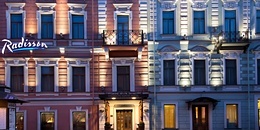Museum of the Defense and Siege of Leningrad
This small but extremely moving museum commemorates perhaps the most harrowing period of the city's history - the 900-day Blockade of Leningrad which lasted from 8 September 1941 to 17 January 1944. For two-and-a-half years, the citizens of Leningrad suffered chronic privations and constant bombardment. Although the precarious Road of Life brought supplies across the ice of Lake Ladoga in the winter months, food was woefully short, fuel was scarce in winter, and in summer the dire state of sanitation spread disease at epidemic levels. In all, over 700,000 civilians died during the Blockade. Their sacrifice and the extraordinary endurance of the survivors is etched on the conscience of the city, a source of immense pride and profound sorrow.

A memorial museum was established around the current site immediately after the end of the blockade, and covered an area over thirty times the size of the present exhibition. A number of 'trophy' Nazi tanks and aircraft were among the 37,000 exhibits, many of which were donated by citizens. Fearing the unifying power of such a monument, Stalin ordered its destruction during his purge of the Leningrad Party in 1948. The museum's director was shot, the larger exhibits were disbursed and destroyed in secret, and the rest were burnt until there was nothing left. It was not until the late eighties that it became possible to re-establish the museum. Once again, Blockade survivors and their families provided most of the exhibits, and the museum reopened on 8 September 1989.
Marked by two anti-aircraft guns flanking its entrance, the new museum is considerably more modest than its predecessor, but still contains some fascinating exhibits. Occupying a long hallway on the third floor of the building (the second floor hosts temporary exhibitions on a variety of connected, normally military, themes), the main exhibition chronicles both the military and the civilian aspects of the blockade. The displays running round the walls tell the story of the advance of the combined German and Finnish forces and their eventual repulsion by the Red Army through photographs, arms and the personal effects of soldiers of all nationalities. Of particular interest are several diaries kept by German officers and the newspaper articles chronicling the feats of Soviet snipers.

The central displays document the even more harrowing civilian experience of the Blockade, and include a wealth of fascinating propaganda material (including anti-Bolshevik leaflets dropped by the Finns and the Nazis into the besieged city), a mock-up of a typical apartment interior of the time, an example of the pitiful daily bread ration (125 grams for a civil servant and his family), and numerous handwritten and drawn testaments to the privations and horrors of life under siege.
Although most of the displays are in Russian, and there is no English-language labeling, it is possible to organize a translator for group tours, and the extremely obliging babushki who work in the museum (many of them children of the Blockade) have enough English to explain the basics of the exhibition, and will do their very best to help out individual travelers who show an interest. To better understand one of the defining events in the city's history, this museum is well worth visiting.
| Location: | 9, Solyanoy Pereulok |
|---|---|
| Metro: | Chernyshevskaya |
| Telephone: | +7 (812) 275-7208 |
| Open: | Thursday to Monday, 10 am to 5 pm. Last admission is at 4 pm. Wednesday, 12.30 am am to 9 pm. |
| Closed: | Tuesdays and the last Thursday of each month |
| Website: | http://blokadamus.ru |
| Admission: | Adult: RUB 300.00. Schoolchildren: RUB 100.00 |
| Accessibility note: | Limited access for wheelchair-bound and limited mobility visitors. Please call in well advance as staff entrance will be required to use elevator/lift. |







